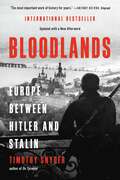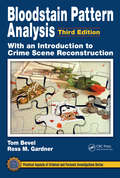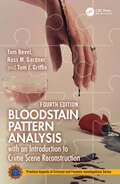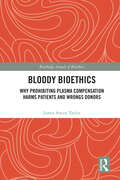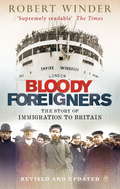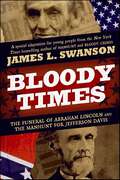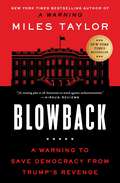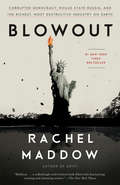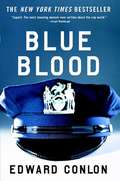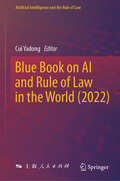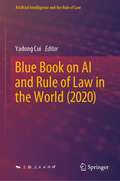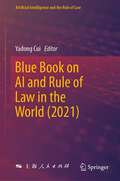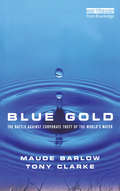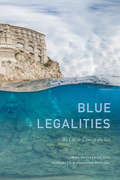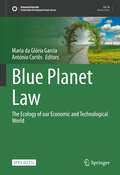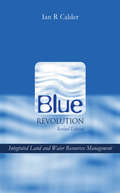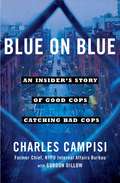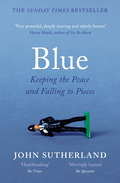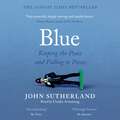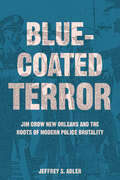- Table View
- List View
Bloodlands: Europe Between Hitler and Stalin
by Timothy SnyderAmericans think of World War II as "The Good War. ” But before it even began, America’s ally Stalin had shot and starved millions of his own citizens; he would continue to do so throughout the war. American soldiers liberated concentration camps, but they never reached the death factories, killing fields, and starvation sites in the East where Hitler and Stalin murdered civilians on a massive scale. In twelve years, in deliberate killing policies unrelated to combat, the Nazi and Soviet regimes killed fourteen million people in a zone of death between Berlin and Moscow. At war’s end, these bloodlands fell behind the iron curtain, leaving their history in darkness. In Bloodlands, acclaimed historian Timothy Snyder offers a groundbreaking investigation of the place where Europeans were murdered by the millions, providing a fresh account of the atrocities perpetrated by the two regimes. Assiduously researched, deeply humane, and utterly definitive, Bloodlands is required reading for anyone seeking to understand the central tragedy of modern history.
Bloodstain Pattern Analysis with an Introduction to Crime Scene Reconstruction (ISSN)
by Ross M. Gardner Tom BevelObjective establishment of the truth is the goal of any good crime scene investigator. This demands a consideration of all evidence available using proven scientific methodologies to establish objective snapshots of the crime. The majority of forensic disciplines shed light on thewho of a crime, bloodstain pattern analysis is one of the most imp
Bloodstain Pattern Analysis with an Introduction to Crime Scene Reconstruction (Practical Aspects of Criminal and Forensic Investigations)
by Ross M. Gardner Tom Bevel Tom J. GriffinBlood Stain Pattern Analysis with an Introduction to Crime Scene Reconstruction, Fourth Edition provides criminal investigators and forensic scientists with a complete and comprehensive handbook on bloodstain pattern analysis.Bringing over 90 combined years of practical experience—and thousands of cases worked collectively—the authors explain the complex mechanics of blood spatter analysis, including anatomical issues relative to bloodstain pattern analysis, a discussion of blood and the circulatory system, and the nature of bleeding associated with various traumatic and non-traumatic injuries. The book also details specific methodologies for crime scene analysis and reconstruction, explaining the proven methodology involved in the process. Such methodology is built upon scientific method and provides focus and structure to the analyst as they evaluate evidence and conduct their work and the investigation.Finally, all chapters are fully revised and updated to address the latest taxonomy and terminology, with over 400 full-color photographs included to illustrate the dynamics of bloodstain pattern analysis.Key features: Presents a specific and detailed taxonomy of bloodstain pattern characteristics, outlining recently updated NIST’s OSAC terminology Includes two full-color fold-outs Decision Map to guide analysts through the classification process Details the theory, principles, and methodology for crime scene reconstruction Expands the bloodstain on clothing chapter, to include new developments in the understanding of bloodstain features and characteristics on cloth Offering practical advice and tips for new and experienced professionals alike, Blood Stain Pattern Analysis with an Introduction to Crime Scene Reconstruction, Fourth Edition offers readers the necessary tools to guide and focus any investigative effort.
Bloodtaking and Peacemaking: Feud, Law, and Society in Saga Iceland
by William Ian MillerDubbed by the New York Times as "one of the most sought-after legal academics in the county," William Ian Miller presents the arcane worlds of the Old Norse studies in a way sure to attract the interest of a wide range of readers. Bloodtaking and Peacemaking delves beneath the chaos and brutality of the Norse world to discover a complex interplay of ordering and disordering impulses. Miller's unique and engaging readings of ancient Iceland's sagas and extensive legal code reconstruct and illuminate the society that produced them. People in the saga world negotiated a maze of violent possibility, with strategies that frequently put life and limb in the balance. But there was a paradox in striking the balance-one could not get even without going one better. Miller shows how blood vengeance, law, and peacemaking were inextricably bound together in the feuding process. This book offers fascinating insights into the politics of a stateless society, its methods of social control, and the role that a uniquely sophisticated and self-conscious law played in the construction of Icelandic society. "Illuminating. "-Rory McTurk, Times Literary Supplement "An impressive achievement in ethnohistory; it is an amalgam of historical research with legal and anthropological interpretation. What is more, and rarer, is that it is a pleasure to read due to the inclusion of narrative case material from the sagas themselves. "-Dan Bauer, Journal of Interdisciplinary History
Bloody Bioethics: Why Prohibiting Plasma Compensation Harms Patients and Wrongs Donors (Routledge Annals of Bioethics)
by James Stacey TaylorThis is the first book to argue in favor of paying people for their blood plasma. It does not merely argue that offering compensation to plasma donors is morally permissible. It argues that prohibiting donor compensation is morally wrong—and that it is morally wrong for all of the reasons that are offered against allowing donor compensation. Opponents of donor compensation claim that it will reduce the amount and quality of plasma obtained, exploit and coerce donors, and undermine social cohesion. James Stacey Taylor argues that empirical evidence demonstrates that compensating plasma donors greatly increases the amount of plasma obtained with no adverse effects on the quality of the pharmaceutical products that are manufactured from it. Prohibiting compensation thus harms patients by reducing their access to the medicines they need. He also argues that it is the prohibition of compensation—not its offer—that exploits donors, fails to respect the moral need to secure a person’s authoritative consent to her treatment, and prevents donors from giving their informed consent to donate. Prohibiting compensation thus not only harms patients but also wrongs donors. Bloody Bioethics will appeal to researchers, advanced students, and medical professionals interested in bioethics, moral philosophy, and the moral limits of markets.
Bloody Foreigners: The Story of Immigration to Britain
by Robert WinderImmigration is one of the most important stories of modern British life, yet it has been happening since Caesar first landed in 53 BC. Ever since the first Roman, Saxon, Jute and Dane leaped off a boat we have been a mongrel nation. Our roots are a tangled web. From Huguenot weavers fleeing French Catholic persecution in the 18th century to South African dentists to Indian shopkeepers; from Jews in York in the 12th century (who had to wear a yellow star to distinguish them and who were shamefully expelled by Edward I in 1272) to the Jamaican who came on board the Windrush in 1947. The first Indian MP was elected in 1892, Walter Tull, the first black football player played (for Spurs and Northampton) before WW1 (and died heroically fighting for the allies in the last months of the war); in 1768 there were 20,000 black people in London (out of a population of 600,000 - a similar percentage to today). The 19th century brought huge numbers of Italians, Irish, Jews (from Russia and Poland mainly), Germans and Poles. This book draws all their stories together in a compelling narrative.
Bloody Foreigners: The Story of Immigration to Britain
by Robert WinderImmigration is one of the most important stories of modern British life, yet it has been happening since Caesar first landed in 53 BC. Ever since the first Roman, Saxon, Jute and Dane leaped off a boat we have been a mongrel nation. Our roots are a tangled web. From Huguenot weavers fleeing French Catholic persecution in the 18th century to South African dentists to Indian shopkeepers; from Jews in York in the 12th century (who had to wear a yellow star to distinguish them and who were shamefully expelled by Edward I in 1272) to the Jamaican who came on board the Windrush in 1947. The first Indian MP was elected in 1892, Walter Tull, the first black football player played (for Spurs and Northampton) before WW1 (and died heroically fighting for the allies in the last months of the war); in 1768 there were 20,000 black people in London (out of a population of 600,000 - a similar percentage to today). The 19th century brought huge numbers of Italians, Irish, Jews (from Russia and Poland mainly), Germans and Poles. This book draws all their stories together in a compelling narrative.
Bloody Times: The Funeral of Abraham Lincoln and the Manhunt for Jefferson Davis
by James L. SwansonNew York Times bestselling author James L. Swanson brings to life the fast-paced, suspense-filled story of Abraham Lincoln's and Jefferson Davis's final journeys through our wounded nation following the Civil War. This middle grade nonfiction book is an excellent choice for tween readers in grades 7 to 8, especially during homeschooling. It’s a fun way to keep your child entertained and engaged while not in the classroom.This suspense-filled true-crime thriller—the young readers’ adaptation of Swanson’s BloodyCrimes—explores two epic events of the Civil War era: the manhunt to apprehend Confederate president Jefferson Davis in the wake of Abraham Lincoln’s assassination and the momentous 20-day funeral pageant that brought President Lincoln’s body from Washington, DC to his home in Springfield. Full of fascinating twists and turns, and lavishly illustrated with dozens of rare historical images, Bloody Times captures the riveting stories of these two fallen leaders who changed the course of history. It’s perfect for young readers who enjoy dramatic nonfiction tales from the likes of Steve Sheinkin and Patricia McCormick.This book contains a note from the author, a glossary, a list of important Civil War figures, and a guide to visiting the historic sites mentioned within. A companion to the bestselling and highly acclaimed Chasing Lincoln's Killer.
Blowback: A Warning to Save Democracy from the Next Trump
by Miles TaylorINSTANT NEW YORK TIMES BESTSELLER The author behind the &“eye-popping&” (CNN) #1 New York Times bestseller A Warning presents an urgent look at how our deeply divided nation is setting the stage for &“The Next Trump.&”Donald Trump will be president again, whether he is on the ballot or not. That is because Trumpism is overtaking the Republican Party and will mount a vigorous comeback, potentially in the hands of a savvier successor—The Next Trump. This prophecy will come true, according to Miles Taylor, if we do not learn the lessons of the recent past. With the 2024 election approaching, the formerly &“Anonymous&” official is back with bombshell revelations and a sobering national forecast. Through interviews with dozens of ex-Trump aides and government leaders, Taylor predicts what could happen inside &“Trump 2.0,&” the White House of a more competent and more formidable copycat. What sounds like a political thriller—from shadowy presidential powers and CIA betrayals to angry henchmen and assassination plots—is instead America&’s political reality, as Taylor uses untold stories to shed light on the ex-President&’s unfulfilled plans, the dark forces haunting our civic lives, and how we can thwart the rise of extremism in the United States. Blowback is also a surprisingly emotional and self-critical portrait of a dissenter, whose own unmasking provides a vivid warning about what happens when we hide the truth from others and, most importantly, ourselves.
Blowing Up Everything Is Beautiful: Israel's Extermination of Gaza
by James RobinsTHEY TOLD YOU WHAT THEY WERE DOING WHILE THEY DID IT &“Blow up and flatten everything . . .&” These chilling words, said by Amichai Eliyahu, a minister in the Israeli government, have been a message to the world and the people of Gaza: destroying everything—homes, businesses, lives—is justified. Even beautiful. For fifteen months and in full view of the world, the state of Israel trapped more than two million people in a tiny strip of land and unleashed vengeance on them. The Palestinians endured a nightmare—bombed from the air, targeted by soldiers, their hospitals destroyed—and, as they are cut off from the rest of the world, the nightmare continues.Blowing Up Everything is Beautiful is a searing indictment of the brutality and atrocities inflicted on the Palestinians of Gaza and the collaboration of powerful nations in their murder. With forensic detail and the forceful arguments of a prosecutor, James Robins details how the ongoing attempt to annihilate Gaza became the major crime of our age—and a turning point. What happens when the moral regime of international law and human rights that protect the oppressed fails? Blowing Up Everything is Beautiful reveals a bold, radical, and independent new voice that offers a powerful reminder: all crimes cry out for justice, and if that justice fails, the crimes will no doubt happen again.
Blowout: Corrupted Democracy, Rogue State Russia, and the Richest, Most Destructive Industry on Earth
by Rachel MaddowBig Oil and Gas Versus Democracy—Winner Take All <P><P>In 2010, the words “earthquake swarm” entered the lexicon in Oklahoma. That same year, a trove of Michael Jackson memorabilia—including his iconic crystal-encrusted white glove—was sold at auction for over $1 million to a guy who was, officially, just the lowly forestry minister of the tiny nation of Equatorial Guinea. And in 2014, Ukrainian revolutionaries raided the palace of their ousted president and found a zoo of peacocks, gilded toilets, and a floating restaurant modeled after a Spanish galleon. <P><P>Unlikely as it might seem, there is a thread connecting these events, and Rachel Maddow follows it to its crooked source: the unimaginably lucrative and equally corrupting oil and gas industry. With her trademark black humor, Maddow takes us on a switchback journey around the globe, revealing the greed and incompetence of Big Oil and Gas along the way, and drawing a surprising conclusion about why the Russian government hacked the 2016 U.S. election. She deftly shows how Russia’s rich reserves of crude have, paradoxically, stunted its growth, forcing Putin to maintain his power by spreading Russia’s rot into its rivals, its neighbors, the West’s most important alliances, and the United States. <P><P>Chevron, BP, and a host of other industry players get their star turn, most notably ExxonMobil and the deceptively well-behaved Rex Tillerson. The oil and gas industry has weakened democracies in developed and developing countries, fouled oceans and rivers, and propped up authoritarian thieves and killers. But being outraged at it is, according to Maddow, “like being indignant when a lion takes down and eats a gazelle. You can’t really blame the lion. It’s in her nature.” <P><P>Blowout is a call to contain the lion: to stop subsidizing the wealthiest businesses on earth, to fight for transparency, and to check the influence of the world’s most destructive industry and its enablers. The stakes have never been higher. As Maddow writes, “Democracy either wins this one or disappears.” <P><P><b>A New York Times Bestseller</b>
Blue Blood
by Edward ConlonEdward Conlon's Blue Blood is an ambitious and extraordinary work of nonfiction about what it means to protect, to serve, and to defend among the ranks of New York's finest. This is an anecdotal history of New York as experienced through its police force, and depicts a portrait of the teeming street life of the city in all its horror and splendor. It is a story about police politics, fathers and sons, partners who become brothers, old ghosts and undying legacies.
Blue Book on AI and Rule of Law in the World (Artificial Intelligence and the Rule of Law)
by Cui YadongThis book focuses on the development of artificial intelligence and rule of law in the world, by collecting and summarizing the information about the development of artificial intelligence and rule of law in China and the world, covering topics like AI strategy, policy, law, theoretical research, practical application, etc. It makes an in-depth analysis so as to provide an objective, fair, and accurate report. The purpose is to promote the study of AI and law, promote the construction of AI and rule of law system, and create an AI and rule of law environment. In particular, it aims to play an active role in promoting the establishment of legislative norms, legal systems, policy systems, and ethical norms that are compatible with the innovative development of AI, promoting the implementation of a new generation of national AI development strategies and ensuring the safe, reliable, controllable, healthy, and sustainable development of AI. It is hoped that this book provides a useful reference for researchers of AI and law.
Blue Book on AI and Rule of Law in the World (Artificial Intelligence and the Rule of Law)
by Yadong CuiThis book focuses on the development of artificial intelligence and rule of law in the current world. It covers topics such as AI strategy, policy, law, theoretical research, and practical application. Through an in-depth analysis and thorough evaluation, this book provides a more objective, fair, accurate and comprehensive report. The purpose is to lead the AI and rule of law research and create an AI and rule of law environment which is conducive to the construction of AI and rule of law system. In particular, it aims to play an active role in promoting the establishment of legal systems, policy systems, and codes of ethics that are compatible with the innovative development of AI, thus facilitating the implementation of a new generation of AI development strategies, and ensuring the safe, reliable, controllable, healthy, and sustainable development of AI.
Blue Book on AI and Rule of Law in the World (Artificial Intelligence and the Rule of Law)
by Yadong CuiThis book focuses on the development of artificial intelligence and rule of law in the world, by collecting and summarizing the information about the development of artificial intelligence and rule of law in China and the world, covering topics like AI strategy, policy, law, theoretical research and practical application, etc. It makes an in-depth analysis so as to provide an objective, fair and accurate report. The purpose is to promote the study of AI and law, promote the construction of AI and rule of law system and create an AI and rule of law environment. In particular, it aims to play an active role in promoting the establishment of legislative norms, legal systems, policy systems and ethical norms that are compatible with the innovative development of AI, promoting the implementation of a new generation of national AI development strategies, ensuring the safe, reliable, controllable, healthy and sustainable development of AI. It is hoped that this book may provide useful reference for researchers of AI and law.
Blue Extinction in Literature, Art, and Culture (Palgrave Studies in Animals and Literature)
by Rachel Murray Vera FibisanBlue Extinction in Literature, Culture, and Art examines literary and cultural representations of aquatic biodiversity loss, bringing together critical perspectives from the blue humanities and extinction studies. It demonstrates the affordances, as well as the limitations, of literary and artistic forms in exposing the plight of aquatic organisms, drawing attention to the social, political, and economic structures that are contributing to their destruction. Together, the essays in this collection demonstrate how literature and art can challenge dominant cultural conceptions and lingering misconceptions surrounding aquatic biodiversity loss, offering new ways of relating to species ranging from whales to oysters.
Blue Gold: The Battle Against Corporate Theft of the World's Water
by Maude Barlow Tony ClarkeInternational tensions around water are rising in many of the world's most volatile regions. The policy recipe pursued by the West, and imposed on governments elsewhere, is to pass control over water to private interests, which simply accelerates the cycle of inequality and deprivation. California, as well as China, South Africa, Mexico and countries on every continent already face a crisis. This book exposes the enormity of the problem, the dangers of the proposed solution and the alternative, which is to recognize access to water as a fundamental human right, not dependent on ability to pay.
Blue Legalities: The Life and Laws of the Sea
by Irus Braverman Elizabeth R. Johnson Eds.The ocean and its inhabitants sketch and stretch our understandings of law in unexpected ways. Inspired by the blue turn in the social sciences and humanities, Blue Legalities explores how regulatory frameworks and governmental infrastructures are made, reworked, and contested in the oceans. Its interdisciplinary contributors analyze topics that range from militarization and Maori cosmologies to island building in the South China Sea and underwater robotics. Throughout, Blue Legalities illuminates the vast and unusual challenges associated with regulating the turbulent materialities and lives of the sea. Offering much more than an analysis of legal frameworks, the chapters in this volume show how the more-than-human ocean is central to the construction of terrestrial institutions and modes of governance. By thinking with the more-than-human ocean, Blue Legalities questions what we think we know—and what we don&’t know—about oceans, our earthly planet, and ourselves. Contributors. Stacy Alaimo, Amy Braun, Irus Braverman, Holly Jean Buck, Jennifer L. Gaynor, Stefan Helmreich, Elizabeth R. Johnson, Stephanie Jones, Zsofia Korosy, Berit Kristoffersen, Jessica Lehman, Astrida Neimanis, Susan Reid, Alison Rieser, Katherine G. Sammler, Astrid Schrader, Kristen L. Shake, Phil Steinberg
Blue Planet Law: The Ecology of our Economic and Technological World (Sustainable Development Goals Series)
by Maria da Glória Garcia António CortêsBlue Planet Law is the global and future-oriented environmental law that is necessary to face the global environmental crisis in the Anthropocene, assuming especially the link between climate action (SDG 13) and ocean sustainability (SDG 14). This open access book focuses on means of overcoming global environmental problems such as climate change, ocean degradation and biodiversity loss and the consequent risks for human life, health, food and wellbeing. It explores how environmental law, at the international, European and national levels, might set economic and technological development on a more sustainable path. Law must engage in dialogue with other areas such as philosophy, economics, ecology, and biology. This book highlights protection of the climate and the oceans and sustainable use of natural resources, through new policies, economies and technologies, including biotechnology, with a view to the preservation of life, health, food and a healthy environment for the present and future generations. The book may be seen as a contribution to the UN Sustainable Development Goals 13 and 14 and a tribute to the Declaration of the United Nations Conference on the Human Environment, also known as the Stockholm Conference (1972), on its 50th Anniversary.
Blue Revolution: Integrated Land and Water Resources Management
by Ian Calder'Blue Revolution upturns some environmental applecarts - not for the hell of it, but so we can manage our environment better.' Fred Pearce, New Scientist This updated and revised edition of The Blue Revolution provides further evidence of the need to integrate land management decision-making into the process of integrated water resources management. It presents the key issues involved in finding the balance between the competing demands for land and water: for food and other forms of economic production, for sustaining livelihoods, and for conservation, amenity, recreation and the requirements of the environment. It also advocates the means and methodologies for addressing them. A new chapter, 'Policies, Power and Perversity,' describes the perverse outcomes that can result from present, often myth-based, land and water policies which do not consider these land and water interactions. New research and case studies involving ILWRM concepts are presented for the Panama Canal catchments and in relation to afforestation proposals for the UK Midlands.
Blue on Blue: An Insider's Story of Good Cops Catching Bad Cops
by Gordon Dillow Charles CampisiOne of the most authentic and consistently illuminating portraits of police work ever, Blue on Blue describes the fascinating inner workings of the world’s largest police force and Chief Charles Campisi’s unprecedented two decades putting bad cops behind bars.From 1996 through 2014 Charles Campisi headed NYPD’s Internal Affairs Bureau, working under four police commissioners and gaining a reputation as hard-nosed and incorruptible. When he retired, only one man on the 36,000-member force had served longer. During Campisi’s IAB tenure, the number of New Yorkers shot, wounded, or killed by cops every year declined by ninety percent, and the number of cops failing integrity tests shrank to an equally startling low. But to achieve those exemplary results, Campisi had to triple IAB’s staff, hire the very best detectives, and put the word out that bad apples wouldn’t be tolerated. While early pages of Campisi’s absorbing account bring us into the real world of cops, showing, for example, the agony that every cop suffers when he fires his gun, later pages spotlight a harrowing series of investigations that tested IAB’s capacities, forcing detectives to go undercover against cops who were themselves undercover, to hunt down criminals posing as cops, and to break through the “blue wall of silence” to verify rare—but sometimes very real—cases of police brutality. Told in an edge-of-the-seat way by a born storyteller, Blue on Blue puts us in the scene, allowing us to listen in on wiretaps and feel the adrenaline rush of drawing in the net. It also reveals new threats to the force, such as the possibility of infiltration by terrorists. Ultimately, the book inspires awe for the man who, for almost two decades, was entrusted with the job of making sure the words “New York’s Finest” never ring hollow. A truly revelatory account, Blue on Blue will forever change the way you view police work.
Blue: A Memoir Keeping the Peace and Falling to Pieces
by John SutherlandA Sunday Times top-five bestseller'This is a remarkable book . . . profound and deeply moving . . . It has as much to tell us about mental illness as it does about policing' Alastair StewartJohn Sutherland joined the Met in 1992, having dreamed of being a police officer since his teens. Rising quickly through the ranks, he experienced all that is extraordinary about a life in blue: saving lives, finding the lost, comforting the broken and helping to take dangerous people off the streets. But for every case with a happy ending, there were others that ended in desperate sadness, and in 2013 John suffered a major breakdown.Blue is his memoir of crime and calamity, of adventure and achievement, of friendship and failure, of serious illness and slow recovery. With searing honesty, it offers an immensely moving and personal insight into what it is to be a police officer in Britain today.
Blue: A Memoir – Keeping the Peace and Falling to Pieces
by John SutherlandA Sunday Times top-five bestseller'This is a remarkable book . . . profound and deeply moving . . . It has as much to tell us about mental illness as it does about policing' Alastair StewartJohn Sutherland joined the Met in 1992, having dreamed of being a police officer since his teens. Rising quickly through the ranks, he experienced all that is extraordinary about a life in blue: saving lives, finding the lost, comforting the broken and helping to take dangerous people off the streets. But for every case with a happy ending, there were others that ended in desperate sadness, and in 2013 John suffered a major breakdown.Blue is his memoir of crime and calamity, of adventure and achievement, of friendship and failure, of serious illness and slow recovery. With searing honesty, it offers an immensely moving and personal insight into what it is to be a police officer in Britain today.
Blue: A Memoir – Keeping the Peace and Falling to Pieces
by John SutherlandA searingly honest memoir of life, policing and falling apart'Every contact leaves a trace'John Sutherland joined the Met in 1992, having dreamed of being a police officer since his teens. Rising quickly through the ranks, and compelled by the opportunity to make a real difference to people's lives, he worked across the capital, experiencing first-hand the enormous satisfaction as well as the endless trauma that a life in blue can bring.There were remarkable, career-defining moments: commanding armed sieges, saving lives and helping to take dangerous people off the streets. But for every case with a happy ending, there were others that ended in desperate sadness.In early 2013, John suffered a major breakdown and consequent battle with crippling depression. After a career spent racing to be the first at the scene of crimes and catastrophes, he found himself in pieces, unable to put one foot in front of the other.Blue is a memoir of crime and calamity, of adventure and achievement, of friendship and failure, of laughter and loss, of the best and the worst of humanity, of serious illness and slow recovery. With searing honesty, it offers an immensely moving and personal insight into what it is to be a police officer in Britain today.
Bluecoated Terror: Jim Crow New Orleans and the Roots of Modern Police Brutality
by Jeffrey S. AdlerA searing chronicle of how racist violence became an ingrained facet of law enforcement in the United States. Too often, scholars and pundits argue either that police violence against African Americans has remained unchanged since the era of slavery or that it is a recent phenomenon and disconnected from the past. Neither view is accurate. In Bluecoated Terror, Jeffrey S. Adler draws on rich archival accounts to show, in narrative detail, how racialized police brutality is part of a larger system of state oppression with roots in the early twentieth-century South, particularly New Orleans. Wide racial differentials in the use of lethal force and beatings during arrest and interrogation emerged in the 1930s and 1940s. Adler explains how race control and crime control blended and blurred during this era, when police officers and criminal justice officials began to justify systemic violence against Black people as a crucial—and legal—tool for maintaining law and order. Bluecoated Terror explores both the rise of these law-enforcement trends and their chilling resilience, providing critical context for recent horrific police abuses as the ghost of Jim Crow law enforcement continues to haunt the nation.
